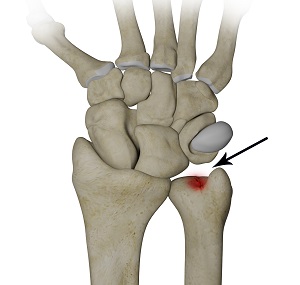
What is Ulnar Carpal Impaction?
The wrist is a complex joint made up of 8 carpal bones aligned in two rows, with four bones present in each row. The carpal bones are further connected to 5 metacarpal bones that form the palm of the hand. Each small bone forms a joint with the bone next to it. Thus, the wrist joint is made up of many small joints. The two bones of the forearm, radius, and ulna, also form a joint with the first row of carpals.
Ulnar carpal impaction also referred to as ulnar impaction syndrome or ulnar abutment or ulnocarpal loading, is a common cause of ulnar sided wrist pain. It is a degenerative condition in which the ulnar head impacts the ulnar-sided carpus and the triangular fibrocartilage complex (TFCC).
Symptoms of Ulnar Carpal Impaction
Symptoms include:
- Chronic or subacute ulnar-sided wrist pain
- Swelling of the wrist
- Limitation of wrist movement
- Limitation of forearm movement
Causes of Ulnar Carpal Impaction
Causes include:
- Previous fracture
- Congenital
- Premature closure of the growth plate
- Radial head resection
- Repeated loading of the ulnar sided-carpus in daily activity
Diagnosis of Ulnar Carpal Impaction
Ulnar carpal impaction is diagnosed with the help of an X-ray and MRI. These tests can assist your doctor in determining the cartilage, bone and ligamentous features of the syndrome.
Treatment for Ulnar Carpal Impaction
Treatment is aimed at removing the mechanical impaction of the ulna with the triangular fibrocartilage complex and ulnar carpal bones. Nonsurgical options include rest, application of ice and medications.
The surgical options may include the following procedures:
- The wafer procedure is performed both as an open procedure and arthroscopically. The open wafer procedure involves surgical resection of the distal 2-3 mm of the ulnar head. The arthroscopic procedure is highly effective which allows you to return to normal activities rapidly.
- Ulnar shortening involves performing an osteotomy in the distal ulnar shaft, followed by rigid fixation with instrumentation.
- Darrach procedure involves complete or partial ulnar head resection which is performed in advanced lesions.
- Sauve´ Kapandji procedure involves arthrodesis of the distal radioulnar joint with distal ulnar pseudoarthrosis.
Prevention of Ulnar Carpal Impaction
You can learn to use certain techniques to avoid wrist problems. Stretching your muscles before starting any exercise or sports activity significantly reduces your risk. Also, remember to stretch the muscles slowly and hold the stretch for some time instead of making many rapid stretches. Warm-up every time before you stretch. Participate in a conditioning program to keep your muscles flexible and strong. Use protective gear that is appropriate for the sports activity you are involved in. Also use of a functional brace to keep the wrist stable may be helpful.

